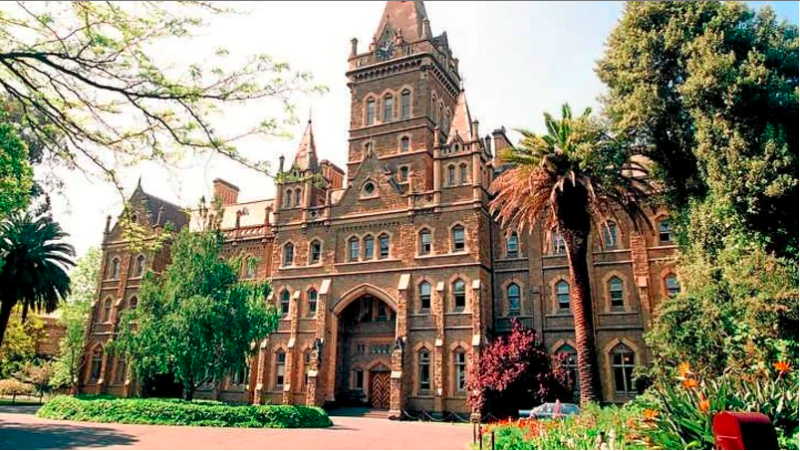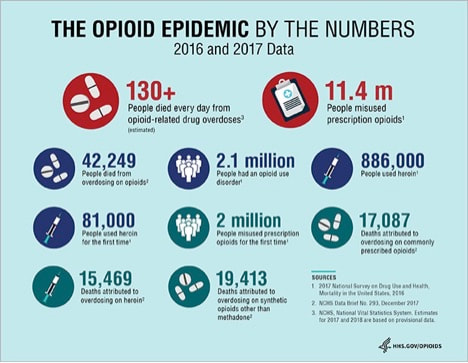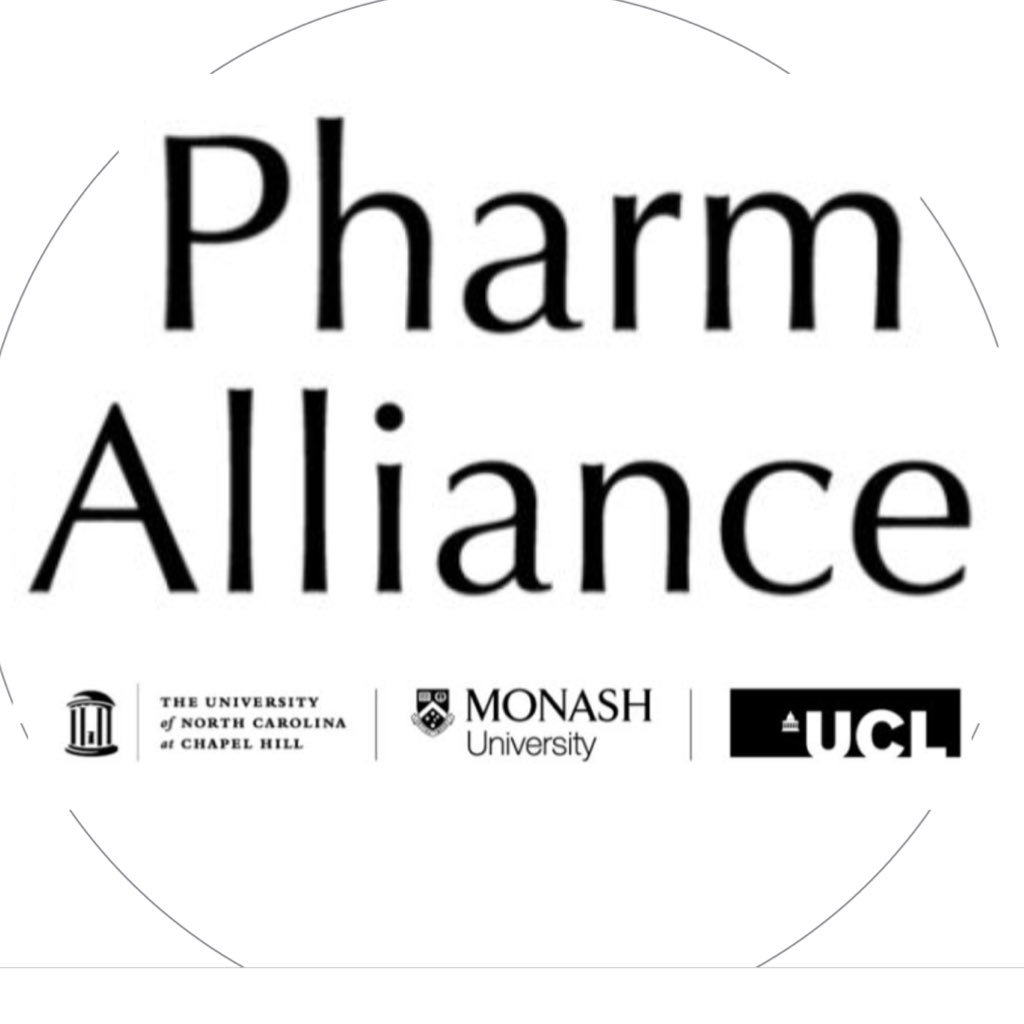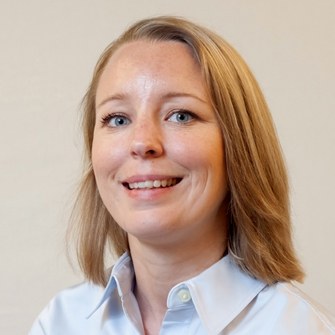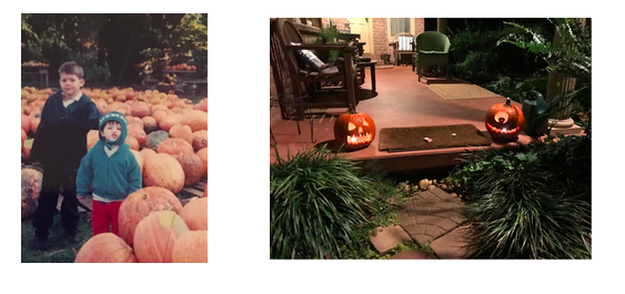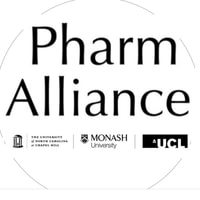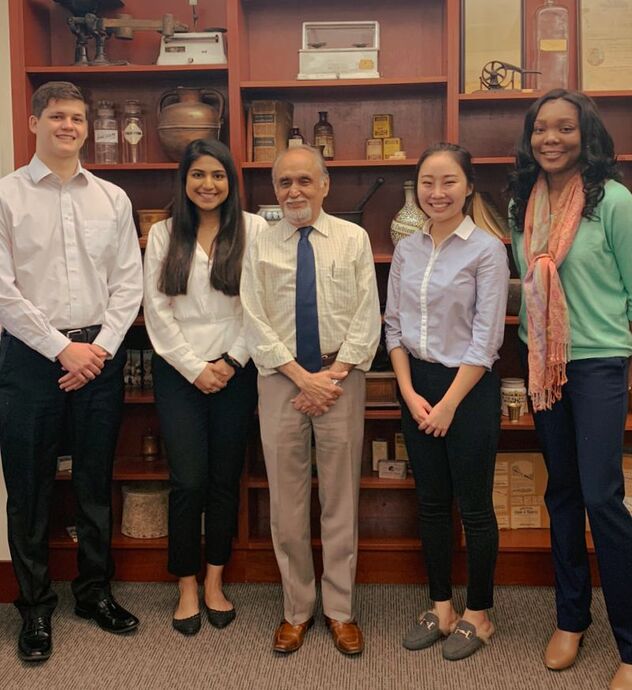 PharmAlliance Students Will Saenger, Asifa Raffi, Stella Ko, and Lauren Creecy after their sit-down interview with Dean Thakker. PharmAlliance Students Will Saenger, Asifa Raffi, Stella Ko, and Lauren Creecy after their sit-down interview with Dean Thakker. The PharmAlliance communications committee for the University of North Carolina at Chapel Hill had the privilege to interview interim Dean Thakker this past Spring. In our lively discussion, we talked about the creation and vision of PharmAlliance, discussed trips and interactions with our international colleagues, and remarked upon the future of having a global reach with pharmacy. *Some of the responses have been paraphrased* 1. We heard that you visited Monash University recently. How was your trip to Melbourne? Dean Thakker: “It was good! This meeting was a very special meeting, it was the first time all domains of PharmAlliance gathered together for a PharmAlliance conference. It was a week-long and we accomplished so much by each domain interacting with one another. For example, education and practice domain exchanged information and ideas so that we can work on a joint project in the future. Next PharmAlliance meeting will be in UNC and I would love to incorporate the format we had from the last meeting in Monash.” 2. Anything specific you thought it was interesting in Monash? Dean Thakker: “What’s special about Monash is the people. They were amazing hosts. Dean Charman from Monash always finds something positive about everyone and I really wish to embody that trait. People in Monash are high performers and I can tell that they genuinely enjoy what they do. I really like the building in Monash as well. They have pictures in bold colors, which shows the image of young institution full of energy. I really want to bring this style of artwork to ESOP as well.” 3.We know you are a huge advocate for PharmAlliance. Why do you think PharmAlliance is important? Dean Thakker: “Well, the whole idea started from the thought that we can’t be in a bubble. We needed to look at the world, learn, and be affected by one another. I want all of the students to be global citizens and be comfortable with different cultures and settings, because I do believe it is a very important skill and competency to have nowadays. So, when I met the dean of UCL, we had an amazing conversation and we shared a lot of similar thoughts about education and it all started from there. I set up a meeting with UNC’s former Dean Blouin and the Dean of UCL, and later on Monash joined our PharmAlliance as well.” 4. What more do you want to see from PharmAlliance? Dean Thakker: “I want each of us to be better schools. I want to create an impact that would not be possible as an individual institution and create some initiatives that will positively impact healthcare globally. For example, antibiotic resistance is a global problem. I would love to see our three institutions working together to solve the global problems as such. Another global problem PharmAlliance could help solve is with counterfeit medicine. Many of these problems are global problems that require technology, education, policy, big pharmaceutical companies, and government. I want our institutions to work together and make a global impact.” 5. One of the long-term goals students came up with in PharmAlliance was potentially being involved in research with faculty in Monash/UCL. Do you think this is a feasible goal and if so how do you think we can accomplish that? Dean Thakker: “The path to having more research collaboration and working with faculty at UCL and Monash is more possible for PhD students. Going to other locations to continue research in a different environment can help catalyze the research and bring in new ideas. PharmD students at Eshelman School of Pharmacy can participate in the Global Pharmacy Scholars (GPS) program which will be focused on service learning going forward.” 6. Recently, the GLIDE module was launched for UNC, UCL, and Monash students to participate what do you expect students to get out from the GLIDE module? Dean Thakker: “We want students to begin to think about what bigger things they can do together. We want to use the program as a next step. Think of it as the base of the pyramid and how can we climb up that.” 7. Do you think as the school gains more international recognition that there is going to be an influx of international students applying to Eshelman School of Pharmacy? Dean Thakker: “Unfortunately it is expensive for international students to come and attend. We are continuously creating resources, such as our negotiation with the China Scholarship Council, which will help students from China in attending Eshelman School of Pharmacy. We are the first pharmacy school to have a relationship with the scholarship council and we currently have the pleasure of welcoming 5 to 6 students a year through the program. Our goal is to continue to bring international diversity to Eshelman School of Pharmacy through either international collaboration or through welcoming international students. We feel that having a more diverse environment leads to more successful graduates.” 8. In 10 years where do you see the Eshelman School of Pharmacy impacting nationally? Dean Thakker: “Our goal is to have the Eshelman School of Pharmacy become the Harvard of pharmacy. We want our name to be instantly recognized and be known for its quality. With Harvard, their alumni network and graduates create the brand in addition with their top-notch faculty. We want to increase faculty collaboration and also are looking at building our partnerships in other parts of the world. We also desire to continue building our relationship with Monash and UCL and continue to collaborate strategically together.” Overall, our discussion with Dean Thakker was insightful and intriguing. We were able to learn about many other exciting developments outside of the scope of the questions asked in the interview, such as the goal of building an endowment so that every student at Eshelman School of Pharmacy can be a Global Pharmacy Scholar! We look forward to seeing the goals of PharmAlliance coming to fruition in the future and thank Dean Thakker very much for his time.
0 Comments
On to the main part of our trip, meetings. With the help of Dr. Andreia Bruno, we were able to book the “Hercules Room” at Monash University-Parkville Campus. Fully equipped with Zoom capable screens and secret cabinets of food and drinks, student leaders discussed not only different projects but also the sustainability and leadership of PharmAlliance student domain. UNC leaders (Clara Kim, Vraj Patel, Jenny Jin, Ember Lu) and Monash University leaders (Alisha Cloti, Kevin Wu, Brandon Pham) were in attendance, while Ruby Akkad from UCL called in from Toronto due to last minute visa issues.
This was the first time that student leaders were able to meet in person. We realized that the value of this face-to-face communication is vital, as the quality of the conversation was much higher and we were able to accomplish much more action items and structures. Ember and I had created meeting agenda templates beforehand, and each school was in charge of different sections of the meeting. Everyone created agendas before their meeting and came well prepared to host the meeting and guide discussions. The first day was spent mostly discussing PharmAlliance student domain leadership so far. The leaders first drafted a mission statement of PharmAlliance student domain: While aligning with initiatives on the PharmAlliance level at the highest possible extent, collaborate on impactful and challenging pharmacy issues that are common between the US, Australia, and the UK. Then, students discussed about different issues with leadership that came up in effectively leading organizations. Students were able to share their experiences and also give advice on how to overcome obstacles. The next day was spent on discussing the Medication Safety Comic series. We decided on logistics, themes, and different topics we want to be included in the comic series. While discussing all of the topics, we made sure that our end goal was having an element of collaboration in each step. Collaboration sometimes may be inefficient; In fact, there are tasks that could easily be done if it were just done within one campus group. However, the leaders were eager to implement collaborative portions across the project, as that is the main goal of PharmAlliance itself. Also, students and leaders in PharmAlliance truly value the unique international collaboration we are fortunate to be a part of, and wanted to take full advantage. The last day was spent discussion the International Case Competition. Vraj Patel and Brandon Pham led the discussions on assessing what was good versus what could be better compared to last year. At the end of the meeting, the leadership team decided to make create interschool teams - i.e. each team will have students from two different countries! This was an exciting development compared to last year, where teams were composed of students in one school. This was again a decision made with the desire to increase collaboration among students across all three countries. We hope that the International Case Competition becomes a unique opportunity for students to learn about each others’ pharmacy practices. It’s no secret that the Opioid Crisis is here to stay. In the United States, over 115 people die from opioid overdose, including prescription opioids, heroin, and synthetic opiates like fentanyl. The Center for Disease Control and Prevention (CDC) estimates that the total cost of healthcare, loss of productivity, addiction treatment and criminal justice involvement totals to $78.5 billion a year in the US alone. Worldwide, it is estimated that 27 million people suffer from opioid use disorders but less than 10% of them who need treatment are receiving it. With opioid use and death from opiate use on the rise, how did we get here?
In later half of the 1990s, pharmaceutical companies had prescription opioid pain relievers on the market but there was concern for addiction. The companies reassured prescribers, pharmacists, and the medical community as a whole that patients would not become addicted to prescription opioid pain relievers. This led to an increase of opioid prescriptions, and widespread abuse of these medications before it was clear to the medical community that these were highly addictive. As addiction rose so did the rate of opioid overdose, by 2015 33,000 American had died from opioid overdose. In present day, doctors are more reluctant to prescribe opioids and their costs on the black market have increased. This drives abusers to street drugs such as heroin. In order to keep up with demand, dealers and suppliers cut their heroin with high potency opioids acquired from overseas like fentanyl. Fentanyl is a synthetic opioid used in patients with severe pain needing long term pain management, and it is 50 to 100 times more potent than morphine. Most fentanyl-related harm come from illegally made fentanyl mixed into heroin, sometimes without the user’s knowledge. The opioid epidemic has become a public health crisis with devastating consequences far beyond the users. There is a rising incidence of neonatal abstinence syndrome (infants born who suffer from opioid withdrawals), plus an increase in intravenous drug use increases the spread of HIV and hepatitis C. In order to combat this, some US states are offering safe needle programs and increasing overdose prevention intervention. One of these agents is known as naloxone. Naloxone is an inexpensive medication that can completely reverse the effects of opioid overdose and prevent death from opioid overdose. New opioid prescribing and dispensing programs have been started, along with continued education on safe opioid prescribing practices for prescribers. The World Health Organization (WHO) recommends tackling the opioid crisis with a variety of treatment options, including psychological support, opioid maintenance treatments such as methadone and buprenorphine and supported detoxification and treatment with reversal agents such as naloxone. The WHO also supports countries where these treatment programs don’t already exist. The United States, and the world has acknowledged the opioid crisis, but we are a long way from solving it. A group of Pharm.D. students received a $10,000 PharmAlliance grant — the first of its kind to be awarded to Pharm.D. students — to support a project promoting medication safety. The project is led by PY3 Clara Kim and PY2 Vraj Patel from the UNC Eshelman School of Pharmacy. It is co-authored by PY3 Ember Lu from the School and students from University College London and Monash University in Melbourne, Australia. Their initiative aims to promote safe use of the three medications most associated with drug errors — opioids, insulins and anticoagulants — through the creation of a comic series that promotes patient education. The comics will be distributed online through social media and offline as posters and fliers posted in community pharmacies in the U.S., England and Australia. “This project will help patients, including those with low health literacy, understand how to take their medications correctly and acknowledge the importance of adherence, while making it fun in the process,” Kim said. Established in 2015, PharmAlliance is an international partnership between the UNC Eshelman School of Pharmacy, University College London and Monash University. PharmAlliance has provided support for research initiatives developed by faculty and Ph.D. students from each of the three schools. This is the first PharmAlliance grant to be awarded to Pharm.D. students. Along with Kim, Patel and Lu, the project’s co-authors include Monash University students Alisha Cloti and Emma Hatherley, and University College of London student Ruby Akkad. “The student leaders of all three schools are very excited and thankful to be the first student group to have received this grant,” Kim said. “This is a very important step for the PharmAlliance student domain.” The students will be mentored by faculty at each school: David Steeb, Pharm.D., M.P.H. at UNC-Chapel Hill, Andreia Bruno, Ph.D. at Monash University, and Oksana Pyzik, M.Pharm. at UCL. The grant will allow the students to develop their project beyond the conceptual stage and travel to Melbourne to discuss their project, as well as ways PharmAlliance can support student initiatives and foster connections between students at each of the schools in the future. Original article found here, published on November 13, 2018 at the UNC Eshelman School of Pharmacy homepage: Dr. Carpenter is an assistant professor in the Division of Pharmaceutical Outcomes and Policy. She is currently involved in diverse research projects such as developing online training module for community pharmacist (suicide prevention and naloxone overdose) and for health professionals to learn how to make decision on pediatric opioid usage. Also, she has a project that collaborates with Monash and UCL where she is developing an app that monitors medical non-adherence of the patient.
Unlike other professors, she received phD in public health and focused on medical adherence during her graduate school. After, she received a postdoctoral award in NIH she got recruited as a research assistant professor in University of North Carolina Eshelman School of Pharmacy. She is currently teaching Social & Behavioral Aspects of Pharmaceutical Use course, which addresses health behavioral series for medication use. In this course, students get to learn about diverse factors that influence medication adherence and several theories that would improve medication adherence of the patient. She is also co-directing the RASP (Research and Scholarship in Pharmacy) project for pharmacy students in UNC Eshelman School of Pharmacy. Lastly we asked Dr. Carpenter for any comments to students who are interested in the field she is currently in.. “Take advantage of PharmAlliance opportunity! I am currently working with pharmD students from UCL as part of their research rotation, so be aware that you can be involved in research projects from different schools. If you are interested in working in research, take advantage of PharmAlliance and reach out to the researchers in different campuses.” State Fair October’s in North Carolina can be described as festive, colorful, and delicious. The North Carolina State Fair is an annual 2 week long event that attracts millions of people from across the state who come to indulge in crazy food, check out the largest pumpkin, and end the night with some festive fireworks. Having lived in NC since I was 3, going to the state fair every year has been a tradition of mine. You can find crazy foods such as Krispy Kreme burgers to 8 pound turkey legs all within a short 5 minute walk from one another. My personal favorites from this past year include the deep fried Reese-O (shown below), and a spicy chipotle cheeseburger from a local vender. Some must-ride attractions are the zipper, centrifuge, and the chair lifts (also pictured below). If you have never been to the State Fair, then you should definitely add it on your bucket list to check out next year! Pumpkins
In addition to the state fair, there are many other activities to do once fall roles around. After eating your weight in food at the fair, you will want one that preferably allows to you sit down and my recommendation is to carve a Jack-O-Lantern! Carving a Jack-O-Lantern is one of my personal favorite and longest running Fall tradition since back when they used to be as big as me (shown below). I get whoever I can and bring them out to a local pumpkin patch with me, pick out the best possible pumpkins, and go home and carve it for Halloween (shown below). Jack-O-Lantern’s are a Halloween and Fall staple and can easily become an elaborate and competitive activity. At the Eshelman School of Pharmacy going out to the pumpkin patch is a bonding activity many of the new initiates into the Fraternities partake in. When you first start out carving you might be in for a bit of a shock because you have to hollow out the pumpkin and it’s quite the messy process. However, afterwards is the fun part of carving! After you are done carving you have to take it outside and light it up with a candle on Halloween night (or for the whole month of October). In addition to having used the pumpkin for creating a Jack-O-Lantern, pumpkins are also used as a spice in many fall seasonal items such as a pumpkin spiced latte, pie, and pumpkin bread! Overall, the Fall season in North Carolina offers many exciting and fun seasonal activities. While the leaves change colors, going to the North Carolina State Fair and carving a Jack-O-Lantern is an excellent way to get immersed in the season all in one day! 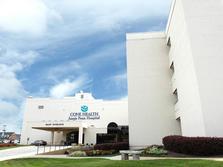 Two PY2 students, Sue Liu and Clara Kim, had immersion experiences in Annie Penn Hospital. Annie Penn hospital is a rural hospital under Cone Health system in Reidsville, North Carolina. It is a single inpatient hospital with services in pulmonology, cardiology, acute management and chronic disease control, with smaller outpatient fills. The immersion itself lasts 2 months. According to Sue, her first month consisted of medication history review in the ER, while the second month was spent shadowing various health care professionals in different departments (e.g. cancer center, respiratory, surgery, and endoscopy), working in the IV room preparing IVs for patients, then later on working up patients, assessing them, and going on rounds with other pharmacists, nurses, case workers, and physicians in the mornings. “All these were valuable experiences for me because they allowed me to see the merit of interdisciplinary work that does on in hospital everyday,” Sue said about her experience. “I was able to see care delivery from one medical professional to another, which was one of the highlights of my rotation.” However, working in the hospital as a PY1 student was not without its challenges. To Clara, who grew up in a city setting, transitioning to a small rural hospital was a surprising change. “I had to drive by cows and horses in the mornings, and once I even had to drive around a tractor that was going 5mph in a two-lane highway. I first felt like an oddball, also being one of the few minorities in the hospital,” she said. However, she soon fell in love with her working environment. “My favorite part of the rotation was how warm the people were,” Clara commented, “Being in a small hospital you may be disappointed at not being able to see more ‘exciting’ medical situations, but the staff are very kind and they have a sense of community.” Sue felt it was a little bit challenging to deal with many drugs and disease states which she had limited exposure to during her first-year training. For instance, community acquired pneumonia and other infectious diseases were a common indication for hospital admissions, but unfortunately were only superficially covered during the first year. It was a challenge that pushed Sue to learn more and faster. She became a self-directed learner, looking up new drugs that she had never encountered before on reputable drug information websites (such as Uptodate.com) and memorizing the brand name, generic name, and adverse effects. “I also asked many questions to people around me, as they had much more experience in working at a hospital,” Sue said. “My preceptor also gave me plenty of feedback to help me improve.” If you have any question about Clara and Sue’s experiences, feel free to email them or comment below! Clara’s email: [email protected] Sue’s email: [email protected] Here are some photos taken by Clara during her immersion: Pharmacy education at Monash Currently at Monash, our degree pathway is changing. When I began university, I entered the Bachelors of Pharmacy straight after completing high school. This degree is 4 years long and incorporates theory and practical components to prepare us for our future career. Students must work as an intern in either a hospital or community pharmacy to gain additional practice experience in the healthcare world to qualify as a practicing pharmacist. After this, they complete the pharmacy board registration exam to practice as a licensed pharmacist. Beginning in 2017, the course of study shifted to a Bachelor of Pharmacy (Honours) /Masters of Pharmacy which students can still enter directly after completing high school but is now a 5 year program. For the 2017 student cohort and onwards, the intern year is incorporated into their degree instead of at the end of the 4 year degree. Education in pharmacy covers a broad range of topics from physics to ethics as the role of a pharmacist is and must be very flexible. At Monash, we have lectures and lab sessions. We even grow bacteria! There are also practical components where students are encouraged to learn how to practice in real life situations. For example, we have OSCE role plays, tutorials with experienced pharmacists, and practical learning through placements in hospitals or community pharmacies. Pharmacy education at UNC ESoP Here at UNC ESoP, students can start applying for pharmacy school as early as their sophomore year of undergraduate studies. Upon submitting all the requirements, selected students are invited to the school for an interview process, also known as candidate’s day at UNC ESoP. UNC ESoP has recently transitioned from traditional interviews to Mini Multiple Interviews (MMI), which consist of seven stations where students have a limited amount of time to discuss the topic for that specific station. Classes at UNC ESoP are organized to help students develop a strong foundation and basic understanding of pharmacy before branching out to take various elective courses, followed by the final 4th year rotation called APPE. With the mindset that the greatest learning curve occurs when students apply their knowledge, UNC ESoP designed the early immersion program that allows students to gain hands-on experience as early as the summer after their first year in pharmacy school, also known as IPPE. IPPE divided into three different immersion experiences spread throughout the first three years of pharmacy school consisting of Health System, Community, and Direct Patient Care Experience. Finally, after all of these experiences, there’s only one other thing left between us and graduating with our Doctorate of Pharmacy (Pharm.D.) degree, which is the North American Pharmacist Licensure Examination (NAPLEX) that every pharmacy student must pass in order to get their pharmacy license. Once completed, students may continue on their pharmacy career path to either apply for pharmacy positions, residency, fellowships, etc. with their Pharm.D. degree. On behalf of UNC ESoP pharmily, I am sending our warmest greetings from the US! Pharmacy education at UCL In the United Kingdom, all students wishing to register as a pharmacist must study the four-year Master of Pharmacy (MPharm.) program. The MPharm. program at UCL gives students an exciting opportunity to study aspects of chemistry and biology: integrating academic knowledge with clinical concepts in order to provide better patient care. During four years of study at university, the central theme is preparing students for practice by taking a holistic approach to education. The course each year is roughly split into four areas. Students study courses in pharmacy practice, chemistry, formulation science and biology using a variety of different teaching styles and methods such as lectures, practicals, tutorials, workshops and seminars. Concepts become more complex with progression through the course with rigorous academic work as part of the student experience. That is being said, the course is rewarding albeit challenging, and keeps the idea of a patient at the heart of all study. Following graduation, each student must complete a 52-week placement in a clinical environment. Upon completion of the placement, students must sit for a final exam regulated by the General Pharmaceutical Council. Successfully passing this exam will allow students to join the register as a fully qualified, practicing pharmacist. |
�
Categories
All
Archives
October 2022
|

